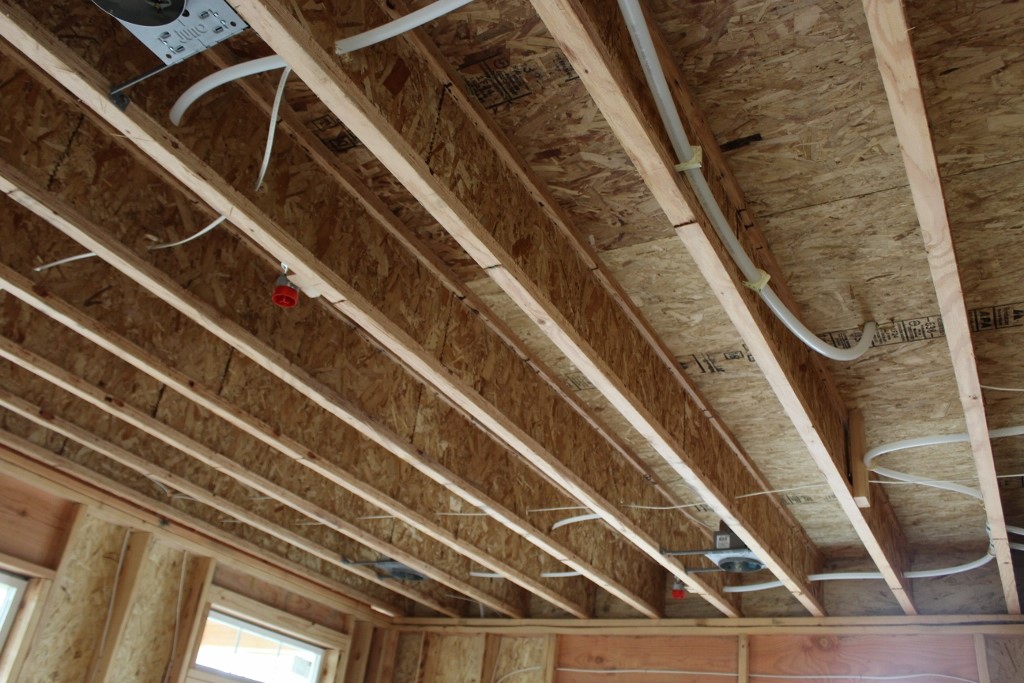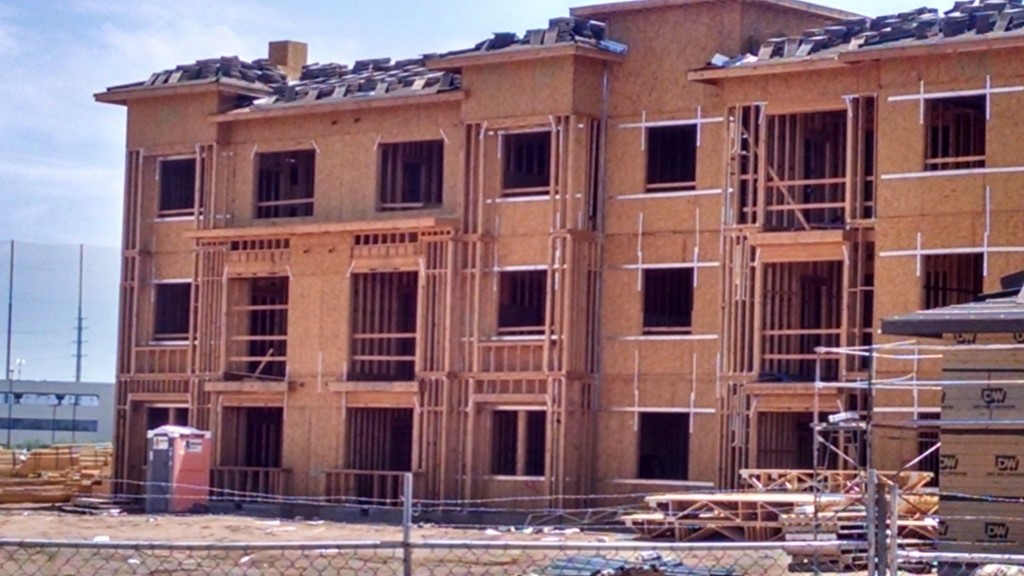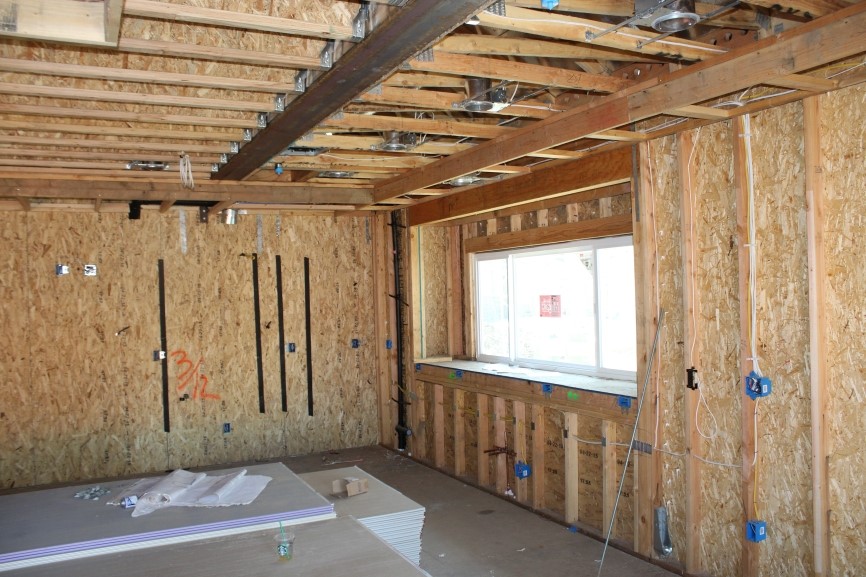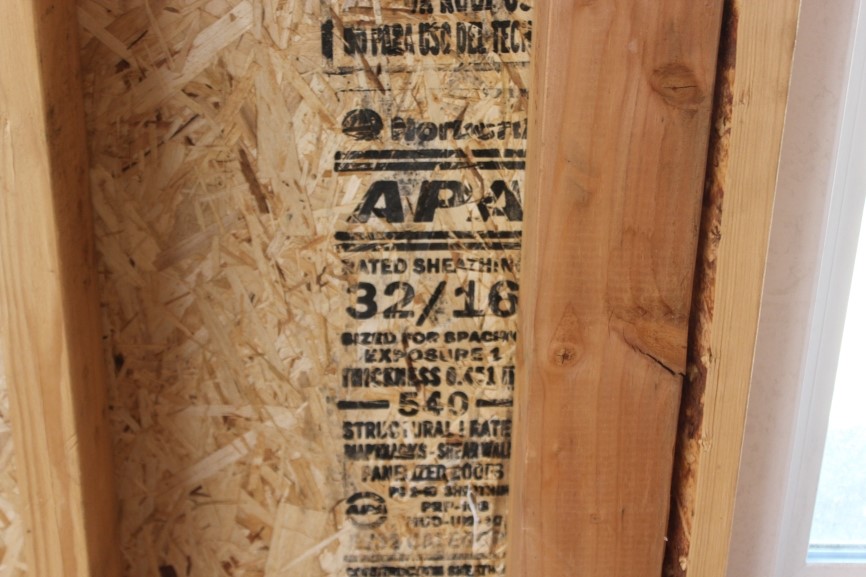By: Mark Crawford - Level 4 Field Consultant & Jeff Hoch - Architect/FC
Oriented Strand Board (OSB) was introduced to the building industry in the late 1970s and quickly became the sheathing material of choice for North American home builders in place of plywood. The reason? OSB sheathing is typically considered to be more economical than plywood.
Over the years, however, a negative stigma has developed in association with OSB, as builders have reported the sheathing to swell, lose structural strength and even develop bio-organic growth (BOG) when exposed to moisture. Being building consultants, many of our Builder Partners have asked us if they should use OSB or plywood on their jobs or if this OSB “epidemic” has yet been re-mediated. Today, we are here to shed some light on the subject!
First and foremost, we will start by stating that OSB and plywood are both great products. However, like anything else, it always comes down to using the right tools for the right job. While the International Building Code defines both OSB and plywood as “wood structural panels” and the American Plywood Association (APA) describes them to be structurally equal, it is important to understand that each product is manufactured differently and therefore perform better under varying circumstances.
What is OSB and How is it Manufactured?
OSB is a structural wood sheathing panel that is primarily made up of hardwoods (aspen, birch and popular) and softwoods (lodgepole pine and southern pine) that are combined with synthetic resin, liquid wax and other additives.
The typical OSB manufacturing process begins with the harvesting of smaller diameter trees than those typically selected for dimensional lumber. OSB panels can be produced from both barked and debarked trees. When the felled trees arrive at the manufacturing plant, the trees are fed into a waferizer that cuts the trees into strands of wood. The size and shape of these wafer strands depends on the waferizer the manufacturer uses and will have some variation in shape due to the process. The cut wafers are then dried to obtain an optimum moisture content that may vary by manufacturer (often as low as 6%). The final moisture content must compensate for the addition of the bonding resins and any other agents that the manufacturer adds to the mix.
As part of the forming process, the wafers are directed to a mat former where the wafers are laid in one direction to form the first face of the panel. Additional mats are then created by placing new wafers in opposing directions to give the panel its structural rigidity. OSB panels are typically made up of three to five mat layers. During the forming process, the resins and other additives are added to the mats. After the forming process is complete, the formed panel is hot pressed to form the panel's final thickness. During this step, the formed panel is subject to both high pressures and temperatures to activate and cure the resins. After the hot pressing and baking processes are complete, the panels are cooled, trimmed, edge-painted and then packaged for shipping.
How is OSB Manufactured Differently than Plywood?
Both OSB and plywood are typically manufactured from trees that are of a smaller diameter than would be harvested for dimensional lumber. They also both involve layers of material instead of being solid pieces of wood like dimensional lumber. They both are engineered products that are available in different structural grades and in various performance grades. Both are composite materials using resins to glue together wood to create a sheet product that is both larger and stronger than the wood alone would have been.
The major differentiator between the two products is the fact that OSB is composed of thousands of small wafers of wood laid out in multiple layers, while plywood is composed of three plus layers of wood veneer sheets. Plywood veneers are created by cutting a prepared tree to size and then using a lath to peel the tree to form a long sheet. This wafer versus veneer has an impact on the way each product reacts to moisture.
Historical Issues Found with OSB
As mentioned previously, OSB has acquired a negative reputation over the years, as builders have reported swelling of their sheathing panels, a decline in structural strength and the presence of BOG when exposed to moisture. Technically, these issues still can occur, however, if the material is stored properly and installed under the appropriate circumstances, these are matters that will not have to be worried about.
The way OSB is manufactured is what makes the product more sensitive to moisture. Natural wood tends to absorb moisture more rapidly through the end grain than through the face grain. For example, dimensional lumber such as a 2 x 4 will absorb moisture more readily through the two ends than through the four faces. However, due to the way the wafers are made in OSB panels, there is a substantially greater amount of end grain exposure present. Knowing this, OSB manufacturers apply an emulsified or slick wax to the surface plane and a primer/sealer to the cut ends during the manufacturing process to protect it.
If the OSB product is stored in wet conditions or is not re-sealed after making cuts to the panels, the product can become something similar to a cellulose sponge. The moisture level will increase and the panel’s size will expand as it tries to revert back to its natural state. At low humidity levels, OSB is a stable product and moisture movement through the panel is not a relative concern. However, at higher moisture levels and extended exposures, moisture movement into the product can cause swelling. In contrast, dimensional lumber and plywood, regardless of if they are kiln dried or not, move in equilibrium to the surrounding humidity level.
What Contributes to the Loss of Structural Strength
Swelling of the OSB panel is the ultimate contributor to the loss of structural strength. This is due to two main concerns:
- A change in the panel thickness will occur while the fastener does not move, resulting in a fastener that is no longer flush to the face of the panel but is essentially overdriven.
- If the swelling is significant enough, the bond within the panel may be lost between the various wafers and the resin.
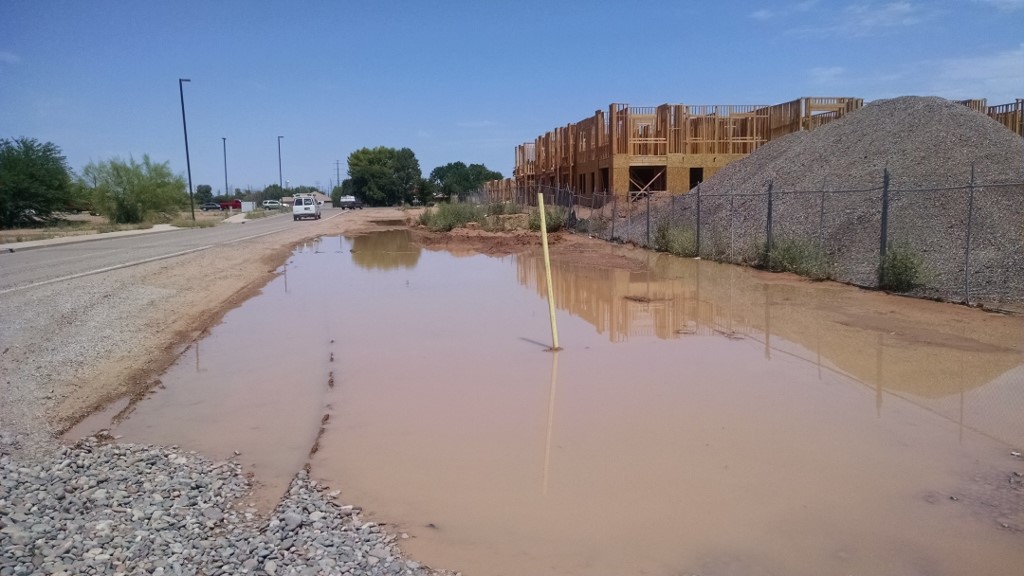 Exposed OSB on a job site following a rainstorm.
Exposed OSB on a job site following a rainstorm.
Problems with Ridges
Edge swell of the panels, especially when used for flooring and roofing, can cause ridges to form when installing finish materials. Additionally, the entire panel may swell due to a change in the moisture content of the panel, and as a result will push against the adjacent panels causing a ridge to emerge. In either case, the ridge may need to be sanded down to allow installation of the finish, resulting in additional costs and time delays. Edge swell is less common in plywood due to the small amount of end grain exposure that it has.
Not All Bio-Organic Growth is Mold
Surface mold has been reported to develop more rapidly on OSB panels than other wood sheathing products. This is due to changes that occur to the physical properties of the wood fibers as a result of the manufacturing process. OSB wood fibers are heated 2.5 times higher and then subjected to a compression ratio that is 48 times higher than a typical plywood panel. The extreme heating and compression of the OSB panel converts some of the cellulose fibers into simple sugars that support rapid mold growth.
Bio-organic growth spores are prevalent in the natural environment, are present on all building materials and are even in the air you are breathing every day. Not all BOG is MOLD and not all MOLD is hazardous to your health. Sometimes mildew is mistaken for hazardous mold and people become unnecessarily concerned. Only an industrial hygienist using laboratory analysis can state for certain if the black BOG you see on the building material is a health risk. For more information on mold, see the EPA report A Brief Guide to Mold, Moisture, and Your Home. The presence of BOG on building materials on a job site does not necessarily indicate poor site management or defective materials. Rather, it is a visual signal that one's "building means and methods" require some revision. BOG can occur due to field conditions present during the delivery, storage, installation, and even normal time delays during the course of construction. These conditions include but are not limited to:
- Moisture being present in either liquid or vapor form.
- Changing temperatures that can cause condensation on the surface of the building product.
- Exposure of the building product to the elements.
- Temperatures and moisture levels that will promote BOG growth.
- A food source for the BOG.
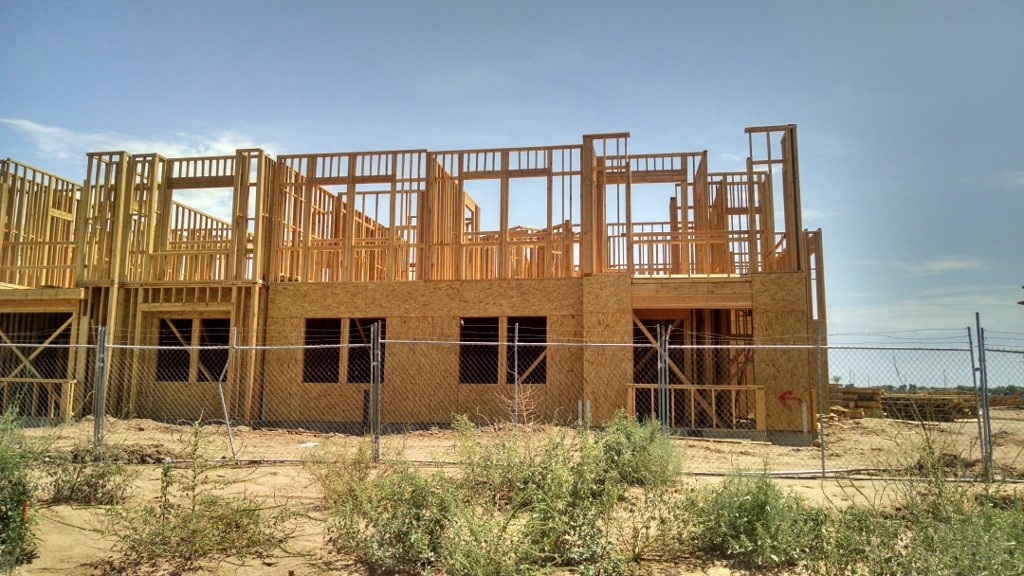 OSB sheathing on stalled project.
OSB sheathing on stalled project.
OSB Today
OSB manufacturers have been working on solutions to overcome the issues that were described above as well as other positive advancements for their products over the years. Various manufacturers have worked on formulations to reduce the overall panel swelling and structural strength loss related to swelling. To accomplish this, manufacturers have modified their resin formulations and/or have added other components to their formulations to provide greater water repellency. The result is that you can now find products that are covered by long no-sand guarantees. These guarantees do not cover continual exposure, however, they do cover occasional exposure during the course of construction.
Some manufacturers have relied on alternate formulations and edge sealing to provide moisture protection. These include:
- Georgia-Pacific - DryMax® High-Performance OSB for which they provide a 500 day no-sand guarantee.
- Huber AdvanTech® Sheathing for walls and roofs with a 500-day weather resistance guarantee.
- Huber AdvanTech® Subflooring with a 500-day no-sand guarantee.
- LP Legacy manufactured with Gorilla Glue for “Superior moisture resistance”.
Some manufacturers have developed drainage features to help reduce the potential for edge swell. These include:
- LP Building Products promotes that their LP Legacy sub-flooring is “Covered Until It’s Covered” by a no-sand warranty. A part of the Legacy sub-flooring design that allows the warranty is the RainChannel® built-in to the panel ends that allow water to drain through at the joints rather than pond on top of the panel.
- Weyerhaeuser Diamond Edge Gold™ Subfloor has Down Pore®. Similar to LP’s RainChannel, this product provides a means to allow water to drain at the joints of sheathing rather than ponding on the surface.
Others have taken different steps to reduce the effects of edge swell or to seal the edge to prevent the swelling:
- Norbord TruFlor PointSix and DuraStrand PointSix have a tapered edge to account for any potential edge swell as the taper of 0.6 mm can expand that same dimension and the edge will be flush. Norbord Stabledge has a 50-year no-sand warranty.
- Telko T-Strand and T-Strand Pro have a proprietary edge seal to protect against edge swell.
Other advancements manufacturers have made include:
- Radiant barriers applied at the factory for panels manufactured by, Georgia Pacific, LP, Norbord, Roy OMartin, Telko, and Weyerhaeuser.
- Weather resistive barriers applied at the factory by, Georgia Pacific, Huber, and Roy OMartin.
- Foam insulation for R value by Huber.
The Various Grades of OSB
Builders should be aware that OSB sheathing is available in various grades and the appropriate grade should be selected in correlation with the circumstances of the job. The grade level will have an impact on the cost of the product and not all grades will perform the same. The following list of available product grades are from the manufacturers websites and are provided in alphabetical order by manufacturer.
Georgia-Pacific manufactures six different OSB products; three of which are able to be used as sub-flooring and two additional OSB products that have a laminated face.
- Blue Ribbon® OSB for roofs and walls with a limited lifetime warranty.
- Blue Ribbon® Sturd-I-Floor® subflooring with a limited lifetime warranty.
- DryGuard® Enhanced OSB with a Limited Lifetime and 200-day no-sand guarantee.
- DryMax® High-Performance with a Limited lifetime and 500-day no-sand guarantee.
- ForceField® Air and Water Barrier as well as Thermostat® Radiant Barrier Sheathing.
Huber Engineered Woods manufactures multiple grades of sheathing with two sub-flooring products and six with specialized uses.
- Huber Blue™ OSB Sheathing is for walls and roofs and has a 25-year limited warranty.
- Huber Blue™ Plus is an alternative to commodity grade subflooring with a 50-year warranty and a 200-day no-sand guarantee and is available with fire rating.
- AdvanTech® Sheathing for walls and roofs with a 500-day weather resistance guarantee and a limited lifetime warranty.
- AdvanTech® Subflooring with a 500-day no-sand guarantee and a limited lifetime warranty.
- PerormMax® 500 laminated facer, Tru-Spec® for millwork, and FormRite® concrete forming board. As well as the ZipSystem™ wall with a laminated weather resistive barrier, ZipSystem™ roof panels with a laminated underlayment and ZipSystem™ R-sheathing with continuous foam insulation applied to the back side of ZipSystem™ wall sheathing.
LP manufactures three grades of OSB panels that are designed for sub-flooring applications. Additionally, they manufacture two additional OSB products that have additional features.
- LP® TopNotch® 250 with a 25-year warranty without a no-sand guarantee.
- LP® TopNotch® 350 with a 50-year warranty and a 100 day no-sand guarantee.
- LP® Legacy™ Sub-Flooring with a “Covered Until It’s Covered” no-sand guarantee and a Limited Lifetime warranty.
- LP® TechShield® Radiant Barrier sheathing and LP® FlameBlock® Fire Rated sheathing.
Norbord manufacturers five grades of sub-flooring and eight specialty products.
- TruFlor commodity level sub-flooring with a 25-year limited warranty without a no-sand guarantee.
- TruFlor PointSix with a 25-year limited warranty without a no-sand guarantee.
- Trubord is for use on roofs and walls and has a 25-year limited warranty.
- Pinnacle subflooring has a 50-year limited warranty and a 100 day no-sand guarantee.
- DuraStrand PointSix with a 1-year no-sand guarantee and a limited lifetime warranty.
- StablEdge premium sub-flooring with a 50-year warranty and a 50-year no-sand guarantee.
- TallWall, Windstorm, and Quakezone have variable sizes to reduce blocking and provide a continuous load path, Solarbord radiant barrier, Stead-I-Tred stair treads, Rim Board, Furniture Frame Grade OSB, and WebStock for use in engineered I-joist.
Roy OMartin manufacturers five varieties of OSB sheathing, not counting their two XL varieties.
- Tuff-Strand has a limited lifetime warranty.
- StructWall structural wall sheathing.
- WindBrace wall sheathing panels.
- Eclipse Radiant Barrier Roof sheathing, Eclipse OSB Wall System sheathing with a radiant barrier air and water barrier, Tuff-StrandXL and StructWall XL are longer format sheets of these product types.
Telko makes nine different OSB products of which two are for sub-flooring.
- T-Strand™ OSB Roof and Wall sheathing carries a 25-year limited warranty.
- T-Strand™ Pro Roof and Wall sheathing carries a 50-year limited warranty as well as a 365 day no-sand guarantee.
- T-Strand™ OSB Subfloor sheathing carries a 25-year limited warranty.
- T-Strand™ Pro Subfloor Sheathing carries a 50-year limited warranty as well as a 365 day no-sand guarantee.
- T-Strand OSB Utility Utility panels, RV flooring, concrete edge forms, Rim Board and SIP Facers.
Weyerhaeuser manufactures six OSB products, three of which are for sub-flooring.
- Edge™ sub-floor commodity grade panels do not have a no-sand guarantee but have a 25 year limited warranty.
- Edge Gold™ Sub-floor with a 200 day no-sand guarantee and 50-year limited warranty.
- Diamond Sub-floor with a 500 day no-sand guarantee and limited lifetime warranty
- Edge Gold™ roofing, Radiant Barrier Sheathing (RBS), and SturdiStep Stair Treads.
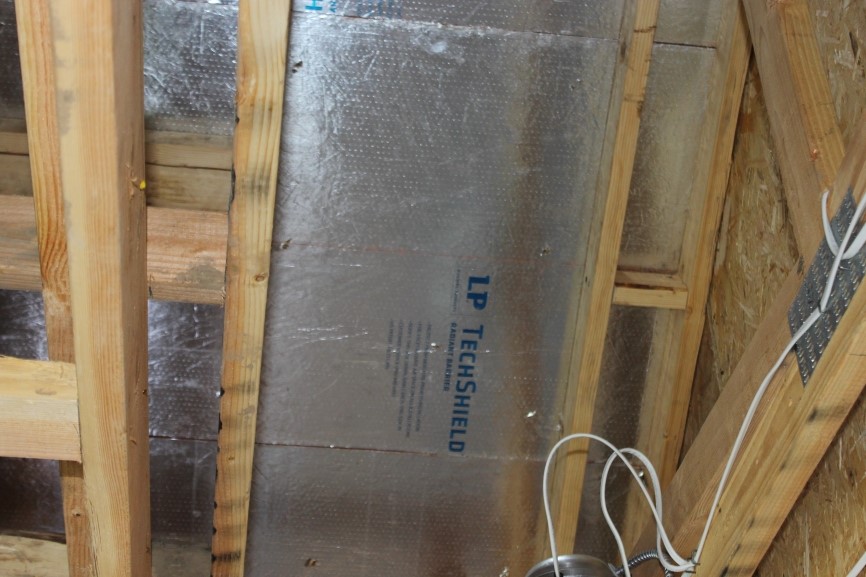 LP TechShield radiant barrier OSB sheathing.
LP TechShield radiant barrier OSB sheathing.
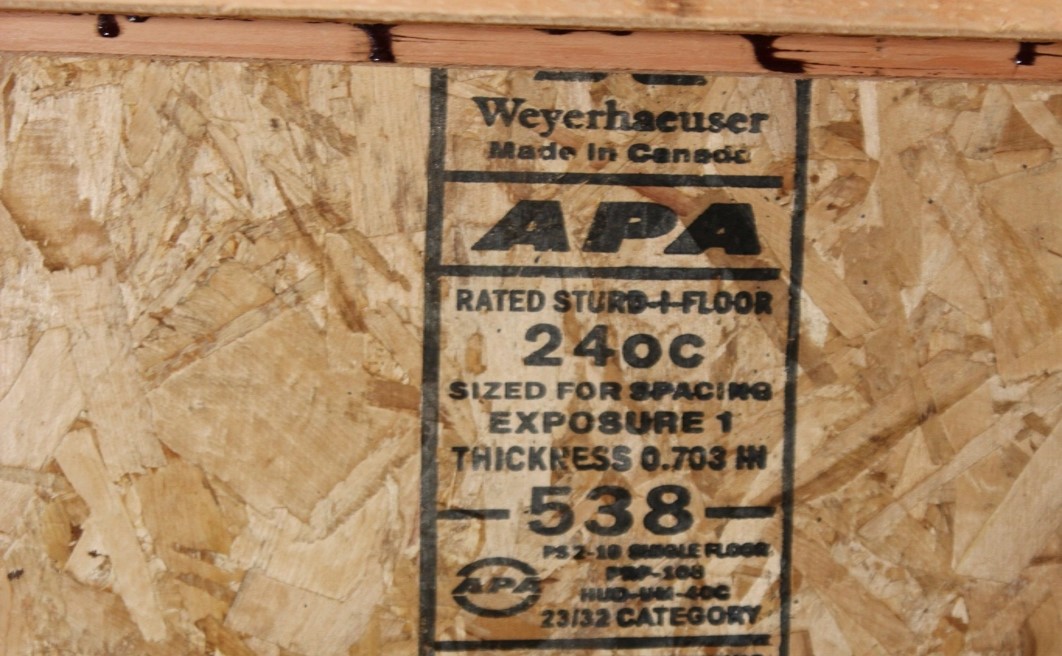 Weyerhaeuser OSB floor sheathing.
Weyerhaeuser OSB floor sheathing.
Are There Areas Where OSB Should Not be Used as Wood Sheathing?
Although today’s OSB manufacturers have taken steps to make their products sturdier and more moisture-resistant, one may ask..."Are there areas where OSB should not be used as wood sheathing?". Unfortunately, there isn't a simple yes or no answer to this question. In areas subject to constant levels of moisture exposure such as, decks, foundations, and behind certain claddings; or where long delays in construction activities are likely to occur, plywood may react in a more favorable way to these conditions than OSB. In some instances, the builder may not even have an option, as the warranties of other products may be partial to specific sheathing types. For example, some deck coating and flooring products have warranties that prohibit the use of any product other than plywood.
In areas such as roof lines, some consultants will recommend plywood over OSB for several reasons. The first is related to edge swell of the panels when using a roofing material such as composition shingles or similar roofing products. When the panel edges swell and these roofing products are installed, the swell lines often become visually apparent even at ground level. While the swelling causes no damage to the roofing and is not necessarily indicative of a structural issue, the owner/occupant of the building can become concerned that structural or roofing issues do exist based on the appearance. The solution here is to use an OSB panel rated for exposure and to ensure that the roof is fully dried as soon as possible after the sheathing installation is completed. Secondly, OSB panels have a higher shear rating than plywood panels and are thus often installed with greater spans than plywood of the same thickness. This can result in visible deflection of the panels between the supports and can telegraph through causing a wavy appearance to the roof. This wavy appearance is often visible from the ground and to the owner/occupant of the building causing concerns about the structural integrity of the roof. The solution here is to work with the structural engineer to reduce the deflection either by using a thicker OSB panel or reducing the span.
It is extremely important to ensure that the wall behind the exterior cladding (especially synthetic stucco applications) is dry prior to resuming construction. This is because moisture will always move from the area of high moisture to areas of low moisture. This is especially a concern with OSB sheathings. Since OSB maintains such a low moisture content, it will invite excess moisture which in turn could saturate the product. For example, synthetic stucco is formed via a chemical process and does not absorb moisture or allow much moisture vapor transmission through the cladding. Thus, the synthetic stucco may inhibit drying towards the outside face of the wall and create an environment that promotes decay of the wood sheathing if it is not properly protected. The same would hold true for any other cladding that could inhibit drying to the exterior of the wall particularly when OSB is used as sheathing on the exterior of the wall. Proper design of the wall system, including the possible integration of a rain screen system, can provide effective protection of the sheathing and make the use of OSB acceptable.
Conclusion
While the feud between plywood and OSB continues, it is important that builders are aware of the potential pitfalls of construction, and steps that can be taken to avoid risk. The way that OSB is manufactured makes it more sensitive to moisture than plywood. However, the price point of OSB sheathing is typically more affordable and therefore has become the sheathing of choice for North American builders. If you are a builder who uses OSB sheathing, paying attention to the way the material is being stored, handled and installed is extremely important. When choosing between plywood or OSB, or even the various grades that are available for each, there are a number of factors that must be considered. To ensure the best outcome, a builder must ask themselves the following questions:
- Where are these structures being built?
- In which weather conditions?
- Are the subcontractors on the job properly trained on installation and best building practices?
- Are the product warranty details being followed?
- Which product would best protect my investment?
Although OSB manufactures have come out with promising new formulations and no-sand guarantees, most consultants would still advise that the builder ensures that the OSB is protected from moisture as much as possible. All manufacturers installation instructions require proper storage prior to installation; including protection from rain and snow as well as vented coverage to prevent moisture vapor build-up. While some exposure may be unavoidable due to typical construction practices, the building should be dried-in as soon as possible to prevent extended exposure of all wood products and other moisture sensitive materials. If panel saturation is present, believed to be present, or panels are showing the early signs of saturation - have the panels inspected to determine if swelling has occurred. If swelling has occurred, a licensed structural engineer should inspect at least a sampling of the sheathing and advise at what point the swelling would warrant removal and replacement of the sheathing. If removal is recommended then remove the affected panel in its entirety. The cost to replace a panel due to saturation during construction or prior to installation will be less than it would take to remove and replace an OSB panel later.
Good building practices will help to prevent damage to the OSB sheathing and result in its effective use. Proper weather-resistive barriers and waterproofing materials to protect the sheathing should be used. Additionally, vented rain screen systems that promote drying of the wall are recommended in general for exterior walls (and particularly with claddings that prevent or inhibit drying to the exterior). For roof and floor assemblies, providing dry-in as soon as possible after installation to prevent moisture exposure is recommended even when using “premium” products with long no-sand guarantees.
To help reduce the risk for builders, Quality Built offers Technical Plan Review services in which we look at the specified products and for indications that products will be used in areas where their use would be acceptable. We also offer Quality Assurance inspections in which we can inspect to verify the OSB sheathing is not installed in conditions that would lead to premature failure. If the questions arise regarding if the product has become damaged, QB can perform Forensic Inspections and testing for moisture levels and thickness swell of the sheathing and document those conditions. Our Technical Services team includes architects and engineers who can assist with repair recommendations if damaged products are encountered.
About the Authors
Mark Crawford is a seasoned Project Manager and Quality Assurance Consultant with over 20 years of expertise in the construction industry. Mark has professionally designed and managed vertical construction and civil improvement projects throughout the United States. He has in-depth knowledge in civil engineering and architecture, along with extensive experience in building inspections, building codes, design standards, local ordinances, forensic building failure analysis, construction defects and expert witness testimony.
You can reach Mark at [email protected]
Jeff Hoch is a licensed architect and has been involved in the construction industry for over 27 years. He has a passion for safety and strives to educate the industry about building best practices and risk mitigation techniques. Jeff is constantly taking part in educational seminars and is extremely knowledgeable when it comes to building code requirements. Jeff performs inspections all across the nation and specializes in forensic inspections, AAMA/ASTM water testing, technical peer plan reviews, quality assurance, and much more. He also is extremely experienced with design standards, local ordinances, forensic building failure analysis, and construction defects.
You can reach Jeff at: [email protected]
